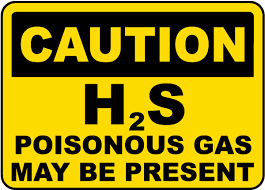Hydrogen sulfide H2S
2 min readHydrogen sulfide is a dangerous toxic gas found in many industries. At low concentrations it causes health problems. At high concentrations it can be lethal. It smells like rotten eggs, but can numb the sense of smell so quickly that workers won’t notice the odour.

How workers are exposed
Hydrogen sulfide is a by-product in many different industries. Some common sources of the gas are:
| Sewage systems |
|
| Agriculture |
|
| Restoration, renovation & demolition |
|
| Mining |
|
| Oil & gas |
|
| Pulp & paper |
|
The risks
Hydrogen sulfide is heavier than air and will settle into low areas. In confined spaces it can quickly reach lethal concentrations.
The common symptoms of exposure to the gas include:
| Low concentration |
|
| High concentration |
|
How to reduce the risks
If workers smell the distinctive rotten egg odour of hydrogen sulfide, they should leave the area immediately and contact a supervisor. Workers can’t always rely on their nose to detect the gas: concentrations of hydrogen sulfide numb the sense of smell, so workers may not notice any odour.
The most effective way to reduce the risk of exposure to the gas is to eliminate the source of exposure. If that’s not possible, there are other risk controls to use. When choosing risk controls, start by asking yourself the questions in the following steps. The steps are listed in order of effectiveness.
- Engineering controls
Making physical modifications to facilities, equipment, and processes can reduce exposure. Some questions to consider:
- Can scrubbers be installed to remove hydrogen sulfide?
- Can ventilation be improved?
- Can air monitoring equipment and warning alarms be installed?
- Can a wind direction indicator be placed near the work area?
- Administrative controls
These involve changing work practices and work policies. Providing awareness tools and training also count as administrative controls. All can limit the risk of hydrogen
 sulfide exposure. Some questions to consider:
sulfide exposure. Some questions to consider:- Have you developed a written exposure control plan for hydrogen sulfide?
- Can warning signs be posted in the work area?
- Can signs explaining exposure symptoms be posted?
- Have you developed a rescue plan for areas where hydrogen sulfide is an extreme hazard?
- Personal protective equipment
This is the least effective control. When used, there must always be at least one other control in place as well. Some questions to consider:
- Do workers have the proper respirators, eye wear, and protective clothing?
- Has personal protective equipment been tested to make sure it is working properly?





1 thought on “Hydrogen sulfide H2S”